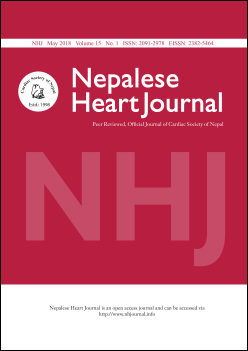Electrocardiographic localization of infarct related coronary artery in acute inferior wall ST elevation myocardial infraction and in hospital outcome in tertiary cardiac care center
DOI:
https://doi.org/10.3126/njh.v15i1.19712Keywords:
aVR, Coronary angiography, Infarct Related Artery, Inferior STEMI.Abstract
Background: In addition to diagnosing the acute ST Elevation MI stratifying (STEMI) high-risk patients and proper treatment strategies are important issues in managing patients. The goal of this study was to determine the relation of ST segment changes in Electrocardigram with the site of occlusion in vessel , to evaluate the prognostic value of ST segment deviation in aVR and its role in identification of Infarct Related Artery (IRA) in patients with acute inferior myocardial infarction.
Methods: The study included 56 patients with acute inferior wall STEMI. All patients underwent Coronary Angiogram. Patients were divided into two groups based on the IRA and were followed up during their hospital stay for complications.
Result: The culprit artery was Right Coronary Artery (RCA) in 40 patients (71.4%) and Left Circumflex Artery (LCX) in 13 patients (23.2%). Study showed 92% sensitivity, 80% specificity for predicting RCA related infarction with ST elevation lead III > lead II and 83% sensitivity ,90% specificity for (LCX) with ST elevation lead II > lead III . The overall in-hospital mortality was 3.5%.
ST depression in aVR was associated with 87.5% specificity and 83% sensitivity in diagnosing LCX as the Infarct Related Artery (IRA). The in-hospital mortality rates for patients with ST segment deviation in aVR (20 patients) and no ST segment changes (36 patients) were 5% and 2.7% respectively.
Conclusion: In addition to the conventional ECG criteria for identifying culprit vessel, lead aVR may be useful in clinical practice when assessing patients with inferior STEMI and with poor in-hospital outcome.
Nepalese Heart Journal 2018; 15(1): 23-27
Downloads
Downloads
Published
How to Cite
Issue
Section
License
This license enables reusers to distribute, remix, adapt, and build upon the material in any medium or format, so long as attribution is given to the creator. The license allows for commercial use.




